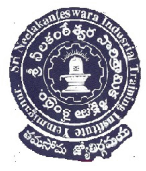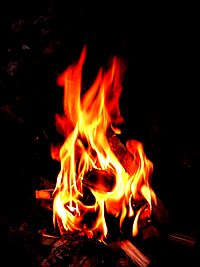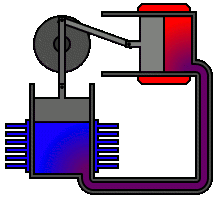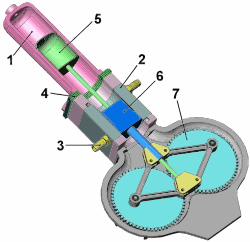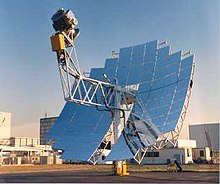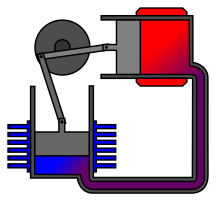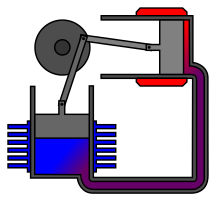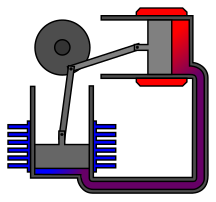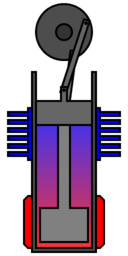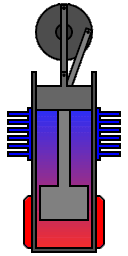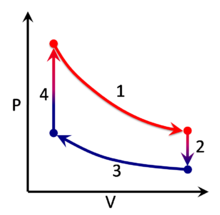A steam
engine is a heat engine that
performs mechanical work using steam as
its working fluid.
Using boiling water to produce
mechanical motion goes back over 2000 years, but early devices were
not practical. The Spanish inventor Jerónimo de Ayanz y
Beaumont patented in 1606 the first steam engine. In
1698 Thomas Savery patented a steam pump that used steam
in direct contact with the water being pumped. Savery's steam pump
used condensing steam to create a vacuum and draw water into a
chamber, and then applied pressurized steam to further pump the
water. The first commercial true steam engine using a piston was
developed by Thomas Newcomen and was used in 1712 for
pumping in a mine. See: Newcomen atmospheric engine
In 1781 James
Watt patented a steam engine that produced continuous rotative
motion. Watt's ten-horsepower engines enabled a wide
range of manufacturing machinery to be powered. The engines could
be sited anywhere that water and coal or wood fuel could
be obtained. By 1883, engines that could provide 10,000 hp had
become feasible. Steam engines could also be applied to
vehicles such as traction engines and the railway
locomotives. The stationary steam engine was a key component of
the Industrial Revolution, allowing factories to locate where
water power was unavailable.
Steam engines are external
combustion engines, where the working fluid is separate from
the combustion products. Non-combustion heat sources such
as solar power, nuclear power or geothermal
energy may be used. The ideal thermodynamic cycle used to
analyze this process is called the Rankine cycle. In the
cycle, water is heated and transforms into steam within a boiler
operating at a high pressure. When expanded through pistons or
turbines, mechanical work is done. The reduced-pressure steam is
then condensed and pumped back into the boiler.
In general usage, the
term steam engine can refer to either the
integrated steam plants (including boilers etc.) such as
railway steam locomotives and portable engines, or
may refer to the piston or turbine machinery alone, as in
the beam engine and stationary steam engine.
Specialized devices such as steam hammers and
steam pile drivers are dependent on steam supplied from a
separate boiler. Reciprocating piston type steam engines
remained the dominant source of power until the early 20th century,
when advances in the design of electric
motors and internal combustion engines gradually
resulted in the replacement of reciprocating (piston) steam engines
in commercial usage, and the ascendancy of steam turbines in power
generation.Considering that the great majority of worldwide
electric generation is produced by turbine type steam engines, the
"steam age" is continuing with energy levels far beyond those of
the turn of the 19th century.
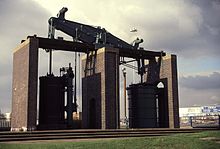
An 1817 Boulton & Watt beamblowing engine, used
in Netherton at the ironworks of M W Grazebrook.
Re-erected on the A38(M) in Birmingham, UK
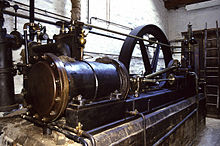
A mill engine from Stott Park Bobbin Mill, Cumbria,
England
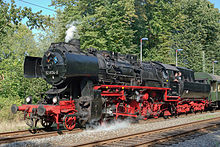
A steam locomotive from East Germany.
This class of engine was built in 1942–1950 and operated
until 1988.
History[edit]
Since the early 18th
century, steam power has been applied to a variety of
practical uses. At first it was applied to reciprocating pumps, but
from the 1780s rotative engines (i.e. those
converting reciprocating motion into rotary motion) began
to appear, driving factory machinery such as spinning
mules and power looms. At the turn of the 19th century,
steam-powered transport on both sea and land began to make its
appearance becoming ever more dominant as the century
progressed.
Steam engines can be said to have
been the moving force behind the Industrial
Revolution and saw widespread commercial use driving machinery
in factories, mills and mines; powering pumping stations; and
propelling transport appliances such as railway locomotives, ships
and road vehicles. Their use in agriculture led to an increase in
the land available for cultivation.
The weight of boilers and
condensors generally makes the power-to-weight ratio of a
steam plant lower than for internal combustion
engines. For mobile applications steam has been largely
superseded by internal combustion engines or electric motors.
However most electric power is generated using steam
turbine plant, so that indirectly the world's industry is
still dependent on steam power. Recent concerns about fuel
sources and pollution have incited a renewed interest in steam both
as a component of cogenerationprocesses and as a prime
mover. This is becoming known as the Advanced
Steam movement.
Early experiments[edit]
The history of the steam engine
stretches back as far as the first century AD; the first recorded
rudimentary steam engine being the aeolipile described
by Greek mathematicianHero of Alexandria. In the
following centuries, the few steam-powered "engines" known were,
like the aeolipile, essentially experimental devices used by
inventors to demonstrate the properties of steam. A
rudimentary steam turbine device was described
by Taqi al-Din in 1551 and by Giovanni
Branca in 1629. Jerónimo de Ayanz y
Beaumont received patents in 1606 for fifty steam powered
inventions, including a water pump for draining inundated
mines. Denis Papin, a Huguenot refugee, did some
useful work on the steam digester in 1679, and first used
a piston to raise weights in 1690.
Pumping engines[edit]
The first commercial steam-powered
device was a water pump, developed in 1698 by Thomas
Savery. It used a vacuum to raise water from below, then used
steam pressure to raise it higher. Small engines were effective
though larger models were problematic. They proved only to have a
limited lift height and were prone to boiler explosions. It
received some use in mines, pumping stations and for
supplying water wheels used to power textile machinery. An
attractive feature of the Savery engine was its low cost. It
continued to be manufactured until the late 18th century. One
engine was still known to be operating in 1820.
Piston steam
engines[edit]

Jacob Leupold Steam
engine 1720
The first commercially successful
true engine, in that it could generate power and transmit it to a
machine, was the atmospheric engine, invented by Thomas
Newcomen around 1712.[18][19] It
made use of technologies discovered by Savery and Papin. Newcomen's
engine was relatively inefficient, and in most cases was used for
pumping water. It worked by creating a partial vacuum by condensing
steam under a piston within a cylinder. It was employed for
draining mine workings at depths hitherto impossible, and also for
providing a reusable water supply for
driving waterwheels at factories sited away from a
suitable "head". Water that had passed over the wheel was pumped
back up into a storage reservoir above the
wheel.[20]
In 1720 Jacob
Leupold described a two-cylinder high-pressure steam
engine.[21] The invention was published in his
major work "Theatri Machinarum
Hydraulicarum".[22] The engine used two
lead-weighted pistons providing a continuous motion to a water
pump. Each piston was raised by the steam pressure and returned to
its original position by gravity. The two pistons shared a common
four way rotary valve connected directly to a steam boiler.
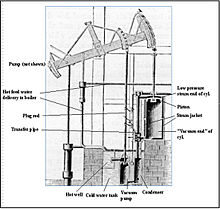
Early Watt pumping engine
The next major step occurred
when James Watt developed (1763–1775) an improved
version of Newcomen's engine, with a separate
condenser. Boulton and Watt's early engines used half as much
coal as John Smeaton's improved version of
Newcomen's. Newcomen's and Watt's early engines were
"atmospheric". They were powered by air pressure pushing a piston
into the partial vacuum generated
bycondensing steam, instead of the pressure of
expanding steam. The engine cylinders had to be large
because the only usable force acting on them was due
to atmospheric pressure.
Watt proceeded to develop his
engine further, modifying it to provide a rotary motion suitable
for driving factory machinery. This enabled factories to be sited
away from rivers, and further accelerated the pace of the
Industrial Revolution.
High-pressure engines[edit]
Around 1800 Richard
Trevithick and, separately, Oliver Evans in
1801 introduced engines using high-pressure steam; Trevithick
obtained his high-pressure engine patent in 1802. These were
much more powerful for a given cylinder size than previous engines
and could be made small enough for transport applications.
Thereafter, technological developments and improvements in
manufacturing techniques (partly brought about by the adoption of
the steam engine as a power source) resulted in the design of more
efficient engines that could be smaller, faster, or more powerful,
depending on the intended application.
The Cornish engine was
developed by Trevithick and others in the 1810s. It was a
compound cycle engine that used high-pressure steam expansively,
then condensed the low-pressure steam, making it relatively
efficient. The Cornish engine had irregular motion and torque
though the cycle, limiting it mainly to pumping. Cornish engines
were used in mines and for water supply until the late 19th
century.
Horizontal stationary
engine[edit]
Main article: Stationary
steam engine
Early builders of stationary steam
engines considered that horizontal cylinders would be subject to
excessive wear. Their engines were therefore arranged with the
piston axis vertical. In time the horizontal arrangement became
more popular, allowing compact, but powerful engines to be fitted
in smaller spaces.
The acme of the horizontal engine
was the Corliss steam engine, patented in 1849, which was a
four-valve counter flow engine with separate steam admission and
exhaust valves and automatic variable steam cutoff. When
introduced, it was called the most significant advance in the steam
engine since James Watt. In addition to using 30% less steam, it
provided more uniform speed due to variable steam cut off, making
it well suited to manufacturing, especially cotton spinning.
Marine
engines[edit]

A triple expansion marine steam
engine on the 1907 ocean going tug
Hercules
Near the end of the 19th century
compound engines came into widespread use. Compound engines
exhausted steam in to successively larger cylinders to accommodate
the higher volumes at reduced pressures, giving improved
efficiency. These stages were called expansions, with double and
triple expansion engines being common, especially in shipping where
efficiency was important to reduce the weight of coal
carried.[20] Steam engines remained the dominant
source of power until the early 20th century, when advances in the
design of electric motors and internal combustion
engines gradually resulted in the replacement of reciprocating
(piston) steam engines, with shipping in the 20th-century relying
upon the steam turbine.[4]
Steam locomotives[edit]
Main articles: Steam
locomotive and Traction engine
As the development of steam engines
progressed through the 18th century, various attempts were made to
apply them to road and railway use.[30] In
1784, William Murdoch, a Scottish inventor, built a
prototype steam road locomotive.[31] An early
working model of a steam rail locomotive was designed and
constructed by steamboat pioneer John Fitch in the United
States probably during the 1780s or 1790s.[32] His
steam locomotive used interior bladed wheels guided by rails or
tracks.
The first full-scale working
railway steam locomotive was built by Richard
Trevithick in the United Kingdom and, on 21 February
1804, the world's first railway journey took place as Trevithick's
unnamed steam locomotive hauled a train along
the tramway from the Pen-y-darren ironworks,
near Merthyr Tydfil to Abercynon in
south Wales.[30][33][34] The
design incorporated a number of important innovations that included
using high-pressure steam which reduced the weight of the engine
and increased its efficiency. Trevithick visited the Newcastle area
later in 1804 and the colliery railways in north-east
England became the leading centre for experimentation and
development of steam locomotives.[35] Trevithick
continued his own experiments using a trio of locomotives,
concluding with the Catch Me Who Can in 1808. Only four
years later, the successful twin-cylinder
locomotiveSalamanca by Matthew Murray was
used by the edge railed rack and pinion Middleton
Railway.[36] In 1825 George
Stephenson built the Locomotion for
the Stockton and Darlington Railway. This was the first public
steam railway in the world and then in 1829, he built The
Rocket which was entered in and won the Rainhill
Trials.[37] The Liverpool and Manchester
Railway opened in 1830 making exclusive use of steam power for
both passenger and freight trains.
Steam locomotives continued to be
manufactured until the late twentieth century in places such
as China and the former East
Germany.[38]
Steam turbines[edit]
Main article: Steam
turbine
The final major evolution of the
steam engine design was the use of
steam turbines starting in the late part of the 19th
century. Steam turbines are generally more efficient than
reciprocating piston type steam engines (for outputs above several
hundred horsepower), have fewer moving parts, and provide rotary
power directly instead of through aconnecting rod system or
similar means.[39] Steam turbines virtually
replaced reciprocating engines in electricity generating stations
early in the 20th century, where their efficiency, higher speed
appropriate to generator service, and smooth rotation were
advantages. Today most electric power is provided by
steam turbines. In the United States 90% of the electric power is
produced in this way using a variety of heat
sources.[4] Steam turbines were extensively applied
for propulsion of large ships throughout most of the 20th
century.
Present development[edit]
Main article: Advanced steam
technology
Although the reciprocating steam
engine is no longer in widespread commercial use, various companies
are exploring or exploiting the potential of the engine as an
alternative to internal combustion engines. The company
Energiprojekt AB in Sweden has made progress in using
modern materials for harnessing the power of steam. The efficiency
of Energiprojekt's steam engine reaches some 27-30% on
high-pressure engines. It is a single-step, 5-cylinder engine (no
compound) with superheated steam and consumes approx. 4 kg
(8.8 lb) of steam per kWh.[40]
Components and accessories of steam
engines[edit]
There are two fundamental
components of a steam plant: the boiler or steam
generator, and the "motor unit", referred to itself as a "steam
engine". Stationary steam engines in fixed buildings may
have the boiler and engine in separate buildings some distance
apart. For portable or mobile use, such as steam locomotives,
the two are mounted together.[41][42]
The widely used reciprocating
engine typically consisted of a cast iron cylinder, piston,
connecting rod and beam or a crank and flywheel, and miscellaneous
linkages. Steam was alternately supplied and exhausted by one or
more valves. Speed control was either automatic, using a governor,
or by a manual valve. The cylinder casting contained steam supply
and exhaust ports.
Engines equipped with a condenser
are a separate type than those that exhaust to the atmosphere.
Other components are often present;
pumps (such as an injector) to supply water to the boiler
during operation, condensers to recirculate the water and recover
the latent heat of vaporisation,
and superheaters to raise the temperature of the steam
above its saturated vapour point, and various mechanisms to
increase the draft for fireboxes. When coal is used, a chain or
screw stoking mechanism and its drive engine or motor may be
included to move the fuel from a supply bin (bunker) to the
firebox.[43] See: Mechanical stoker
Heat
source[edit]
The heat required for boiling the
water and supplying the steam can be derived from various sources,
most commonly from burning combustible materials with an
appropriate supply of air in a closed space (called
variously combustion chamber, firebox). In some cases the
heat source is a nuclear
reactor or geothermal energy.
Boilers[edit]
Main article: Boiler (steam
generator)
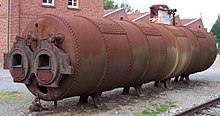
An industrial boiler used for a stationary steam engine
Boilers are pressure
vessels that contain water to be boiled, and some kind of
mechanism for transferring the heat to the water so as to
boil it.[44]
The two most common methods of
transferring heat to the water are:
- water-tube boiler – water is contained in or run through
one or several tubes surrounded by hot gases
- fire-tube boiler – the water partially fills a vessel
below or inside which is a combustion chamber or furnace and fire
tubes through which the hot gases flow
Fire tube boilers were the main
type used for early high-pressure steam (typical steam locomotive
practice), but they were to a large extent displaced by more
economical water tube boilers in the late 19th century for marine
propulsion and large stationary applications.
Once turned to steam, many boilers
raise the temperature of the steam further, turning 'wet steam'
into 'superheated steam'. This use of superheating avoids
the steam condensing within the engine, and allows significantly
greater efficiency.[45]
Motor
units[edit]
- For more details on this topic, see Types of motor
units (below)
A motor unit[citation
needed] takes a supply of steam at high
pressure and temperature and gives out a supply of steam at lower
pressure and temperature, using as much of the difference in steam
energy as possible to do mechanical work. Motor units are typically
a type of piston or steam turbine.
A motor unit is often called 'steam
engine' in its own right. They will also operate on compressed
air or other gas.[citation
needed]
Cold
sink[edit]

A power station's cooling tower produces clouds from the condensing
water vapor due to evaporated cooling water.
As with all heat engines, a
considerable quantity of waste heat at relatively low
temperature is produced and must be disposed of.
The simplest cold sink is to vent
the steam to the environment. This is often used on steam
locomotives, as the released steam is released in the chimney so as
to increase the draw on the fire, which greatly increases engine
power, but is inefficient. Condensing steam
locomotives have been built, but only for special applications
such as working in tunnels and where supplies of water are
scarce.[citation
needed]
Sometimes the waste heat is useful
itself, and in those cases very high overall efficiency can be
obtained. For example, combined heat and power (CHP)
systems use the waste steam for district
heating.[citation
needed]
Where CHP is not used, steam
turbines in power stations use surface condensers as a cold sink.
The condensers are cooled by water flow from oceans, rivers, lakes,
and often by cooling towers which evaporate water to
provide cooling energy removal. The resulting condensed hot water
output from the condenser is then put back into the boiler via a
pump. A dry type cooling tower is similar to an automobile radiator
and is used in locations where water is costly. Evaporative (wet)
cooling towers use the rejected heat to evaporate water; this water
is kept separate from the condensate, which circulates in a closed
system and returns to the boiler. Such towers often have visible
plumes due to the evaporated water condensing into droplets carried
up by the warm air. Evaporative cooling towers need less water flow
than "once-through" cooling by river or lake water; a 700 megawatt
coal-fired power plant may use about 3600 cubic metres of make-up
water every hour for evaporative cooling, but would need about
twenty times as much if cooled by river
water.[citation
needed]
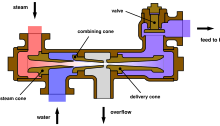
An injector uses a jet of steam to force water into the boiler.
Injectors are inefficient but simple enough to be suitable for use
on locomotives.
Water
pump[edit]
The Rankine cycle and most
practical steam engines have a water pump to recycle or top up the
boiler water, so that they may be run continuously. Utility and
industrial boilers commonly use multi-stage centrifugal pumps;
however, other types are used. Another means of supplying
lower-pressure boiler feed water is an injector, which uses a
steam jet usually supplied from the boiler. Injectors became
popular in the 1850s but are no longer widely used, except in
applications such as steam locomotives.[46]
Monitoring and
control[edit]

Richard's indicator instrument of 1875. See: Indicator diagram
(below)
For safety reasons, nearly all
steam engines are equipped with mechanisms to monitor the boiler,
such as a pressure gauge and a sight glass to
monitor the water level.
Many engines, stationary and
mobile, are also fitted with a governor (see below) to
regulate the speed of the engine without the need for human
interference (similar to cruise control in some cars).
The most useful instrument for
analyzing the performance of steam engines is the steam engine
indicator. Early versions were in use by
1851,[47] but the most successful indicator was
developed for the high speed engine inventor and manufacturer
Charles Porter by Charles Richard and exhibited at London
Exhibition in 1862.[25] The steam engine indicator
traces on paper the pressure in the cylinder throughout the cycle,
which can be used to spot various problems and calculate developed
horsepower.[48] It was routinely used by engineers,
mechanics and insurance inspectors. The engine indicator can also
be used on internal combustion engines. See image of indicator
diagram below (in Types of motor
units section).
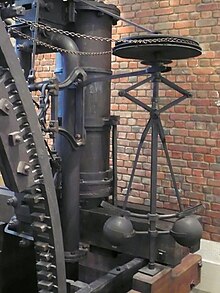
Centrifugal governor in a Boulton & Watt
engine of 1788.
Governor[edit]
Main article: Governor
(device)
The centrifugal governor was
adopted by James Watt for use on a steam engine in 1788 after
Watt’s partner Boulton saw one at a flour millBoulton &
Watt were building.[49] The governor could not
actually hold a set speed, because it would assume a new constant
speed in response to load changes. The governor was able to handle
smaller variations such as those caused by fluctuating heat load to
the boiler. Also, there was a tendency for oscillation whenever
there was a speed change. As a consequence, engines equipped only
with this governor were not suitable for operations requiring
constant speed, such as cotton spinning.[50] The
governor was improved over time and coupled with variable steam cut
off, good speed control in response to changes in load was
attainable near the end of the 19th century.
Engine configuration[edit]
Simple engine[edit]
In a simple engine the charge of
steam works only once in a cylinder.[51] It is then
exhausted directly into the atmosphere or into a condenser. As
steam expands in a high-pressure engine its temperature drops
because no heat is added to the system; this is known asadiabatic
expansion and results in steam entering the cylinder at high
temperature and leaving at low temperature. This causes a cycle of
heating and cooling of the cylinder with every stroke, which is a
source of inefficiency.[52]
Compound engines
Main article: Compound
engine
A method to lessen the magnitude of
this heating and cooling was invented in 1804 by British
engineer Arthur Woolf, who patented hisWoolf
high-pressure compound engine in
1805. In the compound engine, high-pressure steam from the boiler
expands in a high-pressure (HP)
cylinder and then enters one or more
subsequent lower-pressure (LP) cylinders. The
complete expansion of the steam now occurs across multiple
cylinders and as less expansion now occurs in each cylinder less
heat is lost by the steam in each. This reduces the magnitude of
cylinder heating and cooling, increasing the efficiency of the
engine. By staging the expansion in multiple cylinders, torque
variability can be reduced. To derive equal work from
lower-pressure steam requires a larger cylinder volume as this
steam occupies a greater volume. Therefore the bore, and often the
stroke, are increased in low-pressure cylinders resulting in larger
cylinders.[20]
Double expansion (usually known
as compound) engines expanded the steam in
two stages. The pairs may be duplicated or the work of the large
low-pressure cylinder can be split with one high-pressure cylinder
exhausting into one or the other, giving a 3-cylinder layout where
cylinder and piston diameter are about the same making the
reciprocating masses easier to balance.[20]
Two-cylinder compounds can be
arranged as:
- Cross compounds – The cylinders are side
by side.
- Tandem compounds – The cylinders are end
to end, driving a common connecting rod
- Angle compounds – The cylinders are
arranged in a vee (usually at a 90° angle) and drive a common
crank.
With two-cylinder compounds used in
railway work, the pistons are connected to the cranks as with a
two-cylinder simple at 90° out of phase with each other
(quartered). When the double expansion group is
duplicated, producing a 4-cylinder compound, the individual pistons
within the group are usually balanced at 180°, the groups being set
at 90° to each other. In one case (the first type of Vauclain
compound), the pistons worked in the same phase driving a common
crosshead and crank, again set at 90° as for a two-cylinder engine.
With the 3-cylinder compound arrangement, the LP cranks were either
set at 90° with the HP one at 135° to the other two, or in some
cases all three cranks were set at 120°.[citation
needed]
The adoption of compounding was
common for industrial units, for road engines and almost universal
for marine engines after 1880; it was not universally popular in
railway locomotives where it was often perceived as complicated.
This is partly due to the harsh railway operating environment and
limited space afforded by the loading gauge(particularly in
Britain, where compounding was never common and not employed after
1930). However, although never in the majority, it was popular in
many other countries.[53]
Multiple expansion
engines[edit]
Main article: Compound
engine
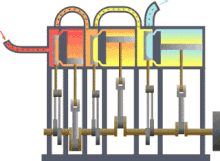
An animation of a simplified triple-expansion engine.
High-pressure steam (red) enters from the boiler and passes through
the engine, exhausting as low-pressure steam (blue), usually to a
condenser.
It is a logical extension of the
compound engine (described above) to split the expansion into yet
more stages to increase efficiency. The result is
the multiple expansion engine. Such engines
use either three or four expansion stages and are known
as triple and quadruple expansion
engines respectively. These engines use a series of
cylinders of progressively increasing diameter. These cylinders are
designed to divide the work into equal shares for each expansion
stage. As with the double expansion engine, if space is at a
premium, then two smaller cylinders may be used for the
low-pressure stage. Multiple expansion engines typically had the
cylinders arranged inline, but various other formations were used.
In the late 19th century, the Yarrow-Schlick-Tweedy balancing
'system' was used on some marine triple expansion engines.
Y-S-T engines divided the low-pressure expansion stages between two
cylinders, one at each end of the engine. This allowed the
crankshaft to be better balanced, resulting in a smoother,
faster-responding engine which ran with less vibration. This made
the 4-cylinder triple-expansion engine popular with large passenger
liners (such as the Olympic class), but this was ultimately
replaced by the virtually vibration-free turbine (see
below).[citation
needed]
The image to the right shows an
animation of a triple expansion engine. The steam travels through
the engine from left to right. The valve chest for each of the
cylinders is to the left of the corresponding cylinder.
Land-based steam engines could
exhaust much of their steam, as feed water was usually readily
available. Prior to and during World War I, the expansion
engine dominated marine applications where high vessel speed was
not essential. It was however superseded by the British
invention steam turbine where speed was required, for
instance in warships, such as the dreadnought battleships,
and ocean liners. HMS Dreadnought of
1905 was the first major warship to replace the proven technology
of the reciprocating engine with the then-novel steam
turbine.[citation
needed][54]
Types of motor
units[edit]
Reciprocating
piston[edit]
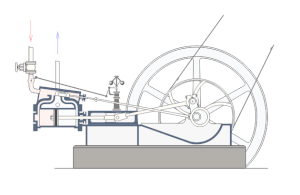
Double acting stationary engine. This was the common mill engine of
the mid 19th century. Note the slide valve with concave, almost "D"
shaped, underside.

Schematic Indicator diagram showing the four events in a
double piston stroke. See: Monitoring and control (above)
Main article: Reciprocating
engine
In most reciprocating piston
engines, the steam reverses its direction of flow at
each stroke (counterflow), entering and exhausting from
the cylinder by the same port. The complete engine cycle occupies
one rotation of the crank and two piston strokes; the cycle also
comprises four events – admission, expansion,
exhaust, compression. These events are controlled by valves often
working inside a steam chest adjacent to the
cylinder; the valves distribute the steam by opening and closing
steam ports communicating with the cylinder
end(s) and are driven by valve gear, of which there are many
types.[citation
needed]The simplest valve gears give events of
fixed length during the engine cycle and often make the engine
rotate in only one direction. Most however have a
reversing mechanism which additionally can provide means
for saving steam as speed and momentum are gained by gradually
"shortening the cutoff" or rather, shortening the admission
event; this in turn proportionately lengthens the expansion period.
However, as one and the same valve usually controls both steam
flows, a short cutoff at admission adversely affects the exhaust
and compression periods which should ideally always be kept fairly
constant; if the exhaust event is too brief, the totality of the
exhaust steam cannot evacuate the cylinder, choking it and giving
excessive compression ("kick back").[citation
needed]
In the 1840s and 50s, there were
attempts to overcome this problem by means of various patent valve
gears with a separate, variable cutoff expansion
valve riding on the back of the main slide valve; the latter
usually had fixed or limited cutoff. The combined setup gave a fair
approximation of the ideal events, at the expense of increased
friction and wear, and the mechanism tended to be complicated. The
usual compromise solution has been to
provide lap by lengthening rubbing surfaces of
the valve in such a way as to overlap the port on the admission
side, with the effect that the exhaust side remains open for a
longer period after cut-off on the admission side has occurred.
This expedient has since been generally considered satisfactory for
most purposes and makes possible the use of the
simpler Stephenson, Joy and Walschaerts motions. Corliss,
and later, poppet valve gears had separate admission and
exhaust valves driven by trip
mechanisms or cams profiled so as to give ideal
events; most of these gears never succeeded outside of the
stationary marketplace due to various other issues including
leakage and more delicate
mechanisms.[53][55]
- Compression
Before the exhaust phase is quite
complete, the exhaust side of the valve closes, shutting a portion
of the exhaust steam inside the cylinder. This determines the
compression phase where a cushion of steam is formed against which
the piston does work whilst its velocity is rapidly decreasing; it
moreover obviates the pressure and temperature shock, which would
otherwise be caused by the sudden admission of the high-pressure
steam at the beginning of the following
cycle.[citation
needed]
- Lead
The above effects are further
enhanced by providing lead: as was later discovered
with the internal combustion engine, it has been found
advantageous since the late 1830s to advance the admission phase,
giving the valve lead so that admission occurs a
little before the end of the exhaust stroke in order to fill
the clearance volume comprising the ports and
the cylinder ends (not part of the piston-swept volume) before the
steam begins to exert effort on the piston.[56]
Uniflow (or unaflow)
engine[edit]
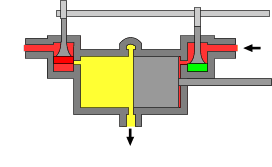
Schematic animation of a uniflow steam engine.
The poppet valves are controlled by the rotating camshaft at the
top. High-pressure steam enters, red, and exhausts, yellow.
Main article: Uniflow steam
engine
Uniflow engines attempt to remedy
the difficulties arising from the usual counterflow cycle where,
during each stroke, the port and the cylinder walls will be cooled
by the passing exhaust steam, whilst the hotter incoming admission
steam will waste some of its energy in restoring working
temperature. The aim of the uniflow is to remedy this defect and
improve efficiency by providing an additional port uncovered by the
piston at the end of each stroke making the steam flow only in one
direction. By this means, the simple-expansion uniflow engine gives
efficiency equivalent to that of classic compound systems with the
added advantage of superior part-load performance, and comparable
efficiency to turbines for smaller engines below one thousand
horsepower. However, the thermal expansion gradient uniflow engines
produce along the cylinder wall gives practical
difficulties.[citation
needed]
Turbine
engines[edit]

A rotor of a modern steam turbine, used in a power plant
Main article: Steam
turbine
A steam turbine consists of one or
more rotors (rotating discs) mounted on a drive
shaft, alternating with a series
of stators (static discs) fixed to the turbine
casing. The rotors have a propeller-like arrangement of blades at
the outer edge. Steam acts upon these blades, producing rotary
motion. The stator consists of a similar, but fixed, series of
blades that serve to redirect the steam flow onto the next rotor
stage. A steam turbine often exhausts into a surface
condenser that provides a vacuum. The stages of a steam
turbine are typically arranged to extract the maximum potential
work from a specific velocity and pressure of steam, giving rise to
a series of variably sized high- and low-pressure stages. Turbines
are only efficient if they rotate at relatively high speed,
therefore they are usually connected to reduction gearing to drive
lower speed applications, such as a ship's propeller. In the vast
majority of large electric generating stations, turbines are
directly connected to generators with no reduction gearing. Typical
speeds are 3600 revolutions per minute (RPM) in the USA with 60
Hertz power, 3000 RPM in Europe and other countries with 50 Hertz
electric power systems. In nuclear power applications the turbines
typically run at half these speeds, 1800 RPM and 1500 RPM. A
turbine rotor is also only capable of providing power when rotating
in one direction. Therefore a reversing stage or gearbox is usually
required where power is required in the opposite
direction.[citation
needed]
Steam turbines provide direct
rotational force and therefore do not require a linkage mechanism
to convert reciprocating to rotary motion. Thus, they produce
smoother rotational forces on the output shaft. This contributes to
a lower maintenance requirement and less wear on the machinery they
power than a comparable reciprocating engine.[citation
needed]

Turbinia – the first steam turbine-powered ship
The main use for steam turbines is
in electricity generation (in the 1990s about 90% of the
world's electric production was by use of steam
turbines)[4] however the recent widespread
application of large gas turbine units and typical combined cycle
power plants has resulted in reduction of this percentage to the
80% regime for steam turbines. In electricity production, the high
speed of turbine rotation matches well with the speed of modern
electric generators, which are typically direct connected to their
driving turbines. In marine service, (pioneered on
the Turbinia), steam turbines with reduction gearing
(although the Turbinia has direct turbines to propellers with no
reduction gearbox) dominated large ship propulsion throughout the
late 20th century, being more efficient (and requiring far less
maintenance) than reciprocating steam engines. In recent decades,
reciprocating Diesel engines, and gas turbines, have almost
entirely supplanted steam propulsion for marine applications.
Virtually all nuclear
power plants generate electricity by heating water to provide
steam that drives a turbine connected to an electrical
generator. Nuclear-powered ships and submarines either
use a steam turbine directly for main propulsion, with generators
providing auxiliary power, or else employ turbo-electric
transmission, where the steam drives a turbo
generator set with propulsion provided by electric motors. A
limited number of steam turbine railroad locomotives were
manufactured. Some non-condensing direct-drive locomotives did meet
with some success for long haul freight operations
in Sweden and for express passenger work in Britain,
but were not repeated. Elsewhere, notably in the U.S.A., more
advanced designs with electric transmission were built
experimentally, but not reproduced. It was found that steam
turbines were not ideally suited to the railroad environment and
these locomotives failed to oust the classic reciprocating steam
unit in the way that modern diesel and electric traction has
done.[citation
needed]

Operation of a simple oscillating cylinder steam engine
Oscillating cylinder steam
engine
An oscillating cylinder steam
engine is a variant of the simple expansion steam engine which does
not require valves to direct steam into and out of the
cylinder. Instead of valves, the entire cylinder rocks, or
oscillates, such that one or more holes in the cylinder line up
with holes in a fixed port face or in the pivot mounting
(trunnion). These engines are mainly used in toys and models,
because of their simplicity, but have also been used in full size
working engines, mainly on ships where their compactness
is valued.[citation
needed]
Rotary steam
engines[edit]
It is possible to use a mechanism
based on a pistonless rotary engine such as
the Wankel engine in place of the cylinders
and valve gearof a conventional reciprocating steam engine.
Many such engines have been designed, from the time of James Watt
to the present day, but relatively few were actually built and even
fewer went into quantity production; see link at bottom of article
for more details. The major problem is
